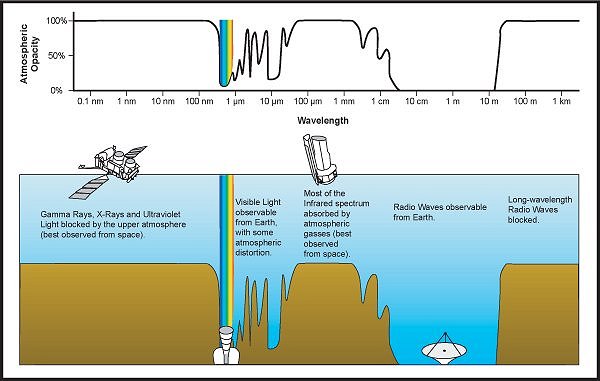




The Universe sends us light all across the electromagnetic spectrum. However, much of this light (or radiation) does not reach the Earth's surface. Our atmosphere blocks out certain types of radiation while letting other types through. Fortunately for life on Earth, our atmosphere blocks out harmful high-energy radiation like X-rays, gamma rays, and most of the ultraviolet rays. The atmosphere also absorbs most of the infrared radiation. On the other hand, our atmosphere is transparent to visible light, most radio waves, and small windows within the infrared region. Ground-based optical and infrared observatories are usually placed near the summits of dry mountains to get above much of the atmosphere. Radio telescopes can operate both day and night from the Earth's surface. These ground-based observatories provide valuable long-term studies of objects in space, but they can only detect the light that passes through our atmosphere.

For the most part, everything we learn about the Universe comes from studying the light emitted by objects in space. To get a complete picture of this amazing and mysterious Universe, we need to examine it in all of its light, using the information sent to us at all wavelengths. This is why it is so important to send observatories into space, to get above the Earth's atmosphere which prevents so much of this information from reaching us.
Astronomers have relied on airplanes flying at high altitudes, on high-altitude balloons, on telescopes mounted in the cargo bay of the Space Shuttle, and on satellites in Earth orbit and in deep space to gather information from the light that does not reach the Earth's surface.
Due to the rapid advance of technology and the ability to send telescopes into space, the future is extremely bright for multiwavelength astronomy. In the coming years and decades, you will continue to hear about many new discoveries being made across the spectrum.
For a list of tutorials on the electromagnetic spectrum and the various
types of astronomy being done in different regions of the electromagnetic
spectrum, please visit our next (and final) page.

|

|

|